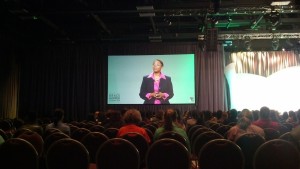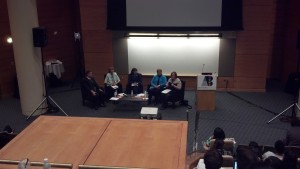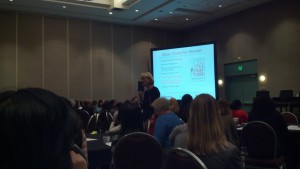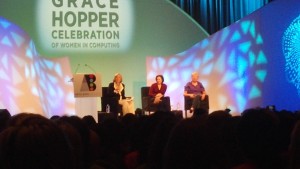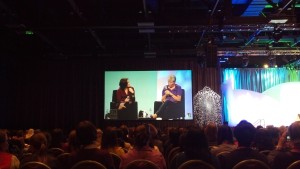If you were expecting a blog on a keynote about DARPA by Arati Prabhakar, you’re in the right place. However, due to the government shutdown, she was unable to travel. Therefore, the new keynote for today was done by Dr. Valerie Harper from Texas A&M and her topic was “A Case for Diversity.”
Even though this presentation was not the one I had intended to blog, it answered a burning question I had had all week. You see, I attended a meeting Wednesday morning before the conference started that was for note-takers and bloggers. In that meeting, they said that the GHC conference had started in 1994 and it was the 13th conference. Huh? I don’t know who was in charge of math here, but I was having a hard time reconciling those numbers.
As it turned out, Valerie Taylor attended the first GHC in 1994. There were 600 attendees. (There are 4817 at this conference). The conference was held every 3 years at that time. In 2000, the conference started to be held every other year and in 2006, it started to be held yearly. Aha!
Valerie visited Anita Borg in 1994 to talk about Valerie’s work. SYSTERS of color was started at that time as a LISTERV group. They held a BOF session at the first GHC and about 15 people attended. At the 2004 GHC, there were more than 100 attended at the women of color BOF. Now, there are multiple subgroups at GHC, not just women of color.
When Anita visited Valerie, Anita said, “Let’s go for a hike!” Valerie was quite puzzled by this and was even more confused when Anita asked her what seemed to be personal questions — about her family, upbringing, etc. Later, Valerie realized that she was just taking time to learn about her so that she would be able to know what she could bring to the table. That led Valerie to learn the following three things about diversity:
- Engage: Take time to learn about others. Learn about their background.
- Embrace: Embrace the background and allow it to come to the forefront.
- Enhance: When you engage and embrace others, you end up with something better than what you started with!
Later when she got a new job, she had to take a 40-hour mediation course. She learned that mediation is not making a decision for the parties in conflict. Rather, it is navigating people in conflict so that they solve the problem themselves. The three things she learned about resolving conflict is the following:
- Conflict is about emotion — how some action made you feel
- You need to use neutral language — watch the adjectives you use. Don’t call one person’s question a good question and the other person’s question a great question.
- Listening — you must repeat what they said to ensure you heard correctly.
Everyone brings something unique to the field of computing! She believes strongly in the following Maya Angelou quote: “We all should know that diversity makes for a rich tapestry, and we must understand that all the threads of the tapestry are equal in value no matter what their color.”
Valerie’s call to action: Take time to engage with each other in depth, embrace backgrounds, and expand with others to use it to enhance the outcome.
One audience question I found quite interesting was the following:
Q: What if you are engaging someone by asking questions and they seem to think the questions are too personal (or vice versa)? Also, how do we know that if we tell someone about our background they aren’t going to stereotype us.
A: Use open-ended questions such as “Tell me about yourself.” Based on their answers, you should be able to tell their comfort level. If you think someone is using a stereotype, talk to them. Don’t let it perpetuate. You can also use it as a chance to educate them.
